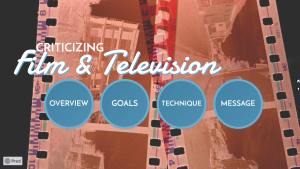29 Film Criticism
Learning Objectives
-
Discover how film criticism techniques can make you a stronger reader.
-
Evaluate arguments in a text, including the validity of the reasoning, and the relevance and sufficiency of the evidence.
Chapter & Discussion
This chapter includes a presentation that can be navigated in a classroom setting or independently. You can access the presentation via the link below.
Guide to Film and Television Analysis
Work through the different sections of the chapter and discuss ideas and topics as they arise. If you’re working independently, take notes instead. Notes and active discussion will be helpful in navigating this week’s assignments.
Overview
The goal of this guide is to offer suggestions on how you can watch film and television to make you a better reader.
Film and television are narrative forms, which means they follow the same rules as novels, and share many of the same elements.
The most important part of the process is that you give yourself an opportunity to think critically about what you watch, and that you have a chance to talk about it.
You can do this through a paper, but the best way to go is through a conversation.

Goals
The first thing to do when analyzing a film is to identify its goals.
If you can figure out what the director was trying to do, you’ll have a much easier time evaluating whether or not they achieved it. Ask yourself:
- Who is the audience for this film?
- Does it have a specific genre?
- What emotions does it want to evoke?
- What does the movie want you to think about?
If you are comparing two films, remember to discuss a shared goal that they both have.
Technique
Next, break down the technical elements of the film. Make sure that for each, you ask yourself “How did this help the film meet one of its goals or communicate a theme?”
Technical Elements:
- Cinematography (the camera work, shots, and images)
- Lighting and Color
- Costume and Makeup Design
- Production Design (things they build)
- Sound and Music
- Editing
- And of course, the acting

Message
Finally, you’ll need to ask yourself “What did this film have to say?”
Identify the movie’s themes and talk about how the director tried to explore them.
Look at the use of devices like figurative language, motifs, and flashbacks. How did these help the director speak on the movie’s themes?
Ultimately, you are trying to get at these questions: What was the movie trying to say to its audience? And, did it do a good job?
Assigned Reading
Here are this week’s readings. Additionally, please read for your own personal enjoyment for 1/2 hour each day. This will be called your “Reading Zone” reading and it will coincide with many upcoming activities.
How to Watch a Movie by Russel Sherman (via Moving Pictures)
Problem Set: Practice Your Skills!
Click here to complete a ten-question problem set on concepts in this chapter.
Completing problem sets like this can be an important element of independent study towards completing your HSE. I write these to resemble the style of questions you’ll find on the Reading and Language Arts GED.
Assignment: Short Film Analysis (250 Words)
Select a film from The New Yorker Short Films Playlist and watch it. As you watch, take notes, attempting to answer the following questions:
-
What topics are explored by the film? Name three.
-
How are these topics explored? What do you think the writer/director have to say about these topics?
-
What can you say about the visual style of the film?
-
Do you think the writer/director are going for realism or not? Explain.
-
Describe a camera shot that was interesting to you. What do you think they were trying to do?
-
Describe a scene that was interesting to you. What do you think they were trying to do?
-
Can you find a motif (a strong visual element that is repeated)?
-
What do you think are some goals of this film?
Assignment: Reading Zone Response (250 Words)
For Reading Zone, you must find a novel that is interesting to you and enjoyable to read. If you need help finding a Reading Zone book, please ask. Please read your Reading Zone book for a half-hour each day. On class days, there will be time in class dedicated to reading.
Create a response to this week’s reading that addresses the following prompts:
-
In one paragraph, summarize what you’ve read this week
-
In a second paragraph, describe a choice the author made that you found unusual. What do you think they were trying to do?
Attributions
Sharman, R. Moving Pictures. University of Arkansas Libraries Open Educational Materials. 2020.
Willems, P.H. How to Analyze Movies. Nebula. Jan 30, 2023.


